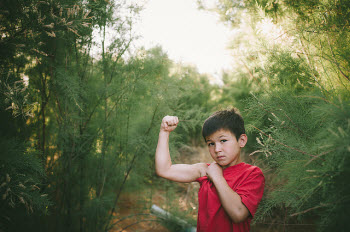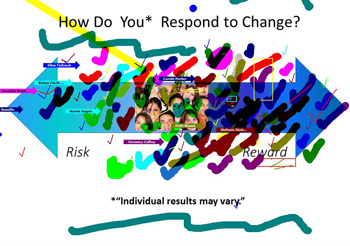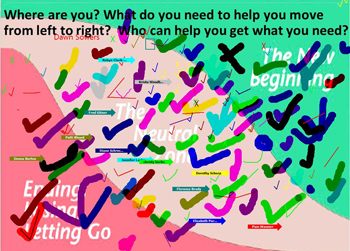Resilient Library, Resilient You
 Libraries and change are two words welded together in this century. News stories abound about libraries making major shifts in direction to retain vitality in an age of rapidly emerging technologies and evolving community needs. Contained within those major upheavals are all the subsidiary changes—new ILS systems, cloud services, mobile devices, learning commons, makerspaces, community engagement, etc.—all challenging library staff to quickly get on board with the changes.
Libraries and change are two words welded together in this century. News stories abound about libraries making major shifts in direction to retain vitality in an age of rapidly emerging technologies and evolving community needs. Contained within those major upheavals are all the subsidiary changes—new ILS systems, cloud services, mobile devices, learning commons, makerspaces, community engagement, etc.—all challenging library staff to quickly get on board with the changes.
Resilience is the ability to adjust readily to change. Characteristics of resilience include anticipation of what might lie ahead, ability to assess a situation and determine the best approach for maintaining balance, flexibility in navigating the unexpected, and readiness to learn. This could describe a system as well as an individual. A resilient library is the sum of its resilient staff. In Public libraries and resilient cities, author Michael Dudley posits that libraries are a backbone of resilient cities, a keystone institution in a thriving city, "a force for reason, insight, wisdom, and inspiration." All the more reason to cultivate qualities of resilience, beginning with ourselves.
In Staying Afloat in a Sea of Change, seasoned change manager Debra Westwood of King County (WA) Library System, purveyed the landscape of our physiological and emotional responses to change and discussed strategies for how to get beyond just surviving change and learn to embrace and thrive in new environments.
"Change in the library is a given. I have been with the library system since the card catalog and date due cards. I say it is like the weather—if you wait long enough it will change. It is all in the attitude and how you can adapt to the change and help your staff adapt too." - Webinar Participant
The Change Continuum
 According to William Bridges, author of Leading Transition: a Model for Change: "Transition is the state that change puts people into. Change is external while transition is internal." Internally, there are universal human responses to change, which involve a tension between the limbic and the prefrontal cortex areas of the brain.
According to William Bridges, author of Leading Transition: a Model for Change: "Transition is the state that change puts people into. Change is external while transition is internal." Internally, there are universal human responses to change, which involve a tension between the limbic and the prefrontal cortex areas of the brain.
- The limbic "lizard" brain is ancient, inherited from fish; its response is all about survival, kicking in automatically to defend against perceived attack to its safety and comfort. It is this part of the brain that resists anything new introduced into its environment, or at least sniffs it very suspiciously and thoroughly before proceeding.
- The prefrontal cortex is the highly evolved part of our brains that is the center of creativity; it desires stimulation and is rewarded by excitement of the new. Stimulating this area of the brain increases vitality in all aspects of our lives.
Models of Change
Models of change describe stages people typically go through to make the transition from the initial limbic defense response to acceptance and embrace of change. The five stages of grief defined by Elizabeth Kubler-Ross is probably the most famous model. Although there is some value in recognizing organizational change as a grieving process, the Bridges model is less encumbered and more applicable to work life. The model has three phases:
 Endings, letting go: Something always has to give way to the new. There is a sense of loss, a feeling of invalidation of the competencies devoted to that thing that will no longer be done; there is confusion about how to redirect energy. It is critical to articulate the why of change to make it compelling and overcome the "grief."
Endings, letting go: Something always has to give way to the new. There is a sense of loss, a feeling of invalidation of the competencies devoted to that thing that will no longer be done; there is confusion about how to redirect energy. It is critical to articulate the why of change to make it compelling and overcome the "grief."- Neutral zone: This middle ground or "wilderness" is not a wasteland to move through quickly. It is actually where transition is activated. It is the time for clear communication about the purpose, the big picture, the plan for moving forward, and the part each person plays in helping to make things happen. People lean in to the situation and begin adding ideas and articulating new attitudes to advance the change.
- New beginning: With clear articulation of the new behaviors and attitudes, staff begin to work actively toward the desired impacts of the change. Early adopters model behaviors for others who are still in the neutral zone. Training and resources help, as well as allowing ample time to accommodate the various rates at which people enter this phase.
The limitation of any model of change is the implication of a finish line to be crossed, a plateau to be reached, after which a new normal will allow the return to equilibrium. Life, especially modern life, is a process of iterative, agile development. Outputs are never perfect or final. As soon as one behavior adaptation is achieved, another external force reshuffles the deck, takes a 90-degree turn. Imagine the Bridges model drawn in a circle: ending/losing >> neutral zone >> new beginning >> ending/losing >> neutral zone >> new beginning >> ending/losing ad infinitum.
"I am in the process of moving beyond change to transformation. Libraries are in the midst of their own historical arc so change can be frustrating when there is not a REAL bottom or settling point. Transformation I think allows me more flexibility... I call it ‘trusting the process.'" - Webinar Participant
 Building Your Resilience
Building Your Resilience
Resilience is a process, an ongoing one. Attaining resilience in the face of such iteration is like mastering sailing. When setting sail upon open waters, it is a fact of life that there will always be change in conditions—weather, tides, currents, actions of other boaters, personalities of the crew are all unpredictable elements that can change in an instant and often compound each other. The skilled sailor learns to expect constant change and is always ready to adjust to the unexpected, improvise solutions, maintain a positive balance and stay on course to the extent possible. The seasoned sailor reflects on past experience and learns from it to strengthen resilience for the next challenge.
Fortunately resilience can be built up. Westwood shared some key tips for successful navigation through the transitions imposed by change. She also offers a learner guide for personal navigation through a particular change event.
- Identify what's really changing
- Identify your resources and allies
- Pick your new destination
- Plan your route
- Take care of yourself: webinar participants flooded the chat with ideas for reducing stress. (Starts at line 181 in the chat log.)
